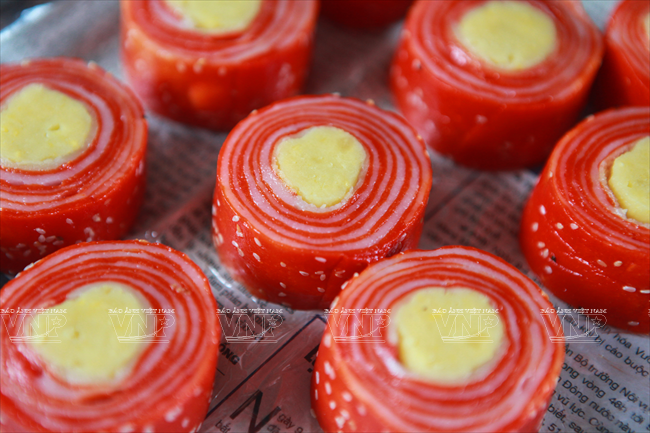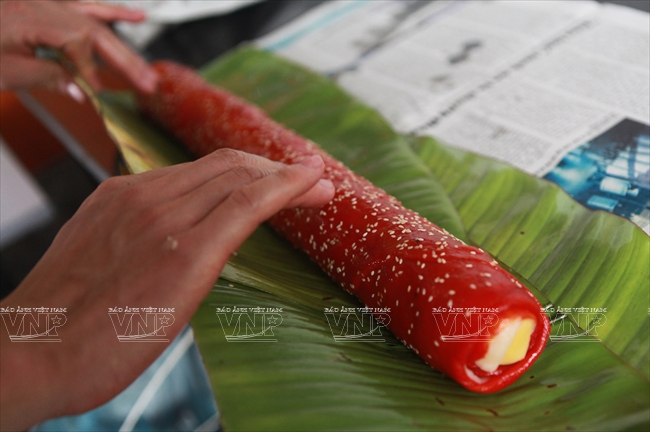It is not clear who first made the “Bac” cake but it is believed that the cake first appeared in the 6th century under the reign of King Ly Nam De, and it used to be presented to the kings, lords and the court.
“Bac” is the local term for “fry”, but the frying method of people in Giang Xa Village (Tram Troi Town, Hoai Duc District, Hanoi) is far different from the normal way that we know.
Necessary ingredients for “Bac” cake include glutinous rice flour, cochinchin gourd or Gac fruit, mung bean, lard, sugar and sesame seeds. The most difficult stage is to make the cake’s outer skin with glutinous rice flour. Half of the flour must be mixed with Gac flesh to create the red colour for the cake’s crust which then should be fried in lard. “In order to make a delicious outer skin, one has to touch it by his fingers to know its thickness and see if it is well done. Spoons cannot deliver the exact feel,” said baker Do Phu Thu (74 year olds), one of the most famous bakers in Giang Xa Village.
 “Bac” cake is a famous specialty of old Hanoians which was used as a tribute to kings. Photo: Nguyen Quyen/VNP
“Bac” cake is a famous specialty of old Hanoians which was used as a tribute to kings. Photo: Nguyen Quyen/VNP

Completed cakes will be rolled into plantain leaves for about 2 hours before being cut into pieces.
Photo: Nguyen Quyen/VNP

The cake has the red colour of Gac fruit, yellow from green beans and white from sesame seeds.
Photo: Nguyen Quyen/VNP

The cake is free from preservatives. Photo: Nguyen Quyen/VNP
The old man shared his own experience while busily spreading flour over the boiling hot pan. He acknowledged that frying over a wood fire can create a unique smell which other methods of cooking cannot. It takes years of practice to get acquainted with the intense heat of the pan, not to mention injuries like burns or blisters. The frying method is so hard to achieve that not everyone can imitate it and there are about 15 households in Giang Xa Village that maintain the ancient technique.
After the inner filling of mung bean is cooked, it is folded into sticks of 30cm to be rolled up with 2 pieces of red and white skin. Sesame seeds are spread outside lastly. A completed “Bac” cake will then be covered with plantain leaves. After 2 hours, when the cake is firm and has cooled down, it will be uncovered and cut into small pieces.
“Bac” cake possesses both a beautiful appearance and a pleasant aroma of Gac fruit that cannot be mistaken for any other type. The most demanding taster will surely be lured by the delicious taste formed by the sweet inner mung bean paste mixed with the sticky, crunchy outer skin. Bac” cake is free from additives or preservatives while all the stages are carried out by hands./.
By Nguyen Quyen